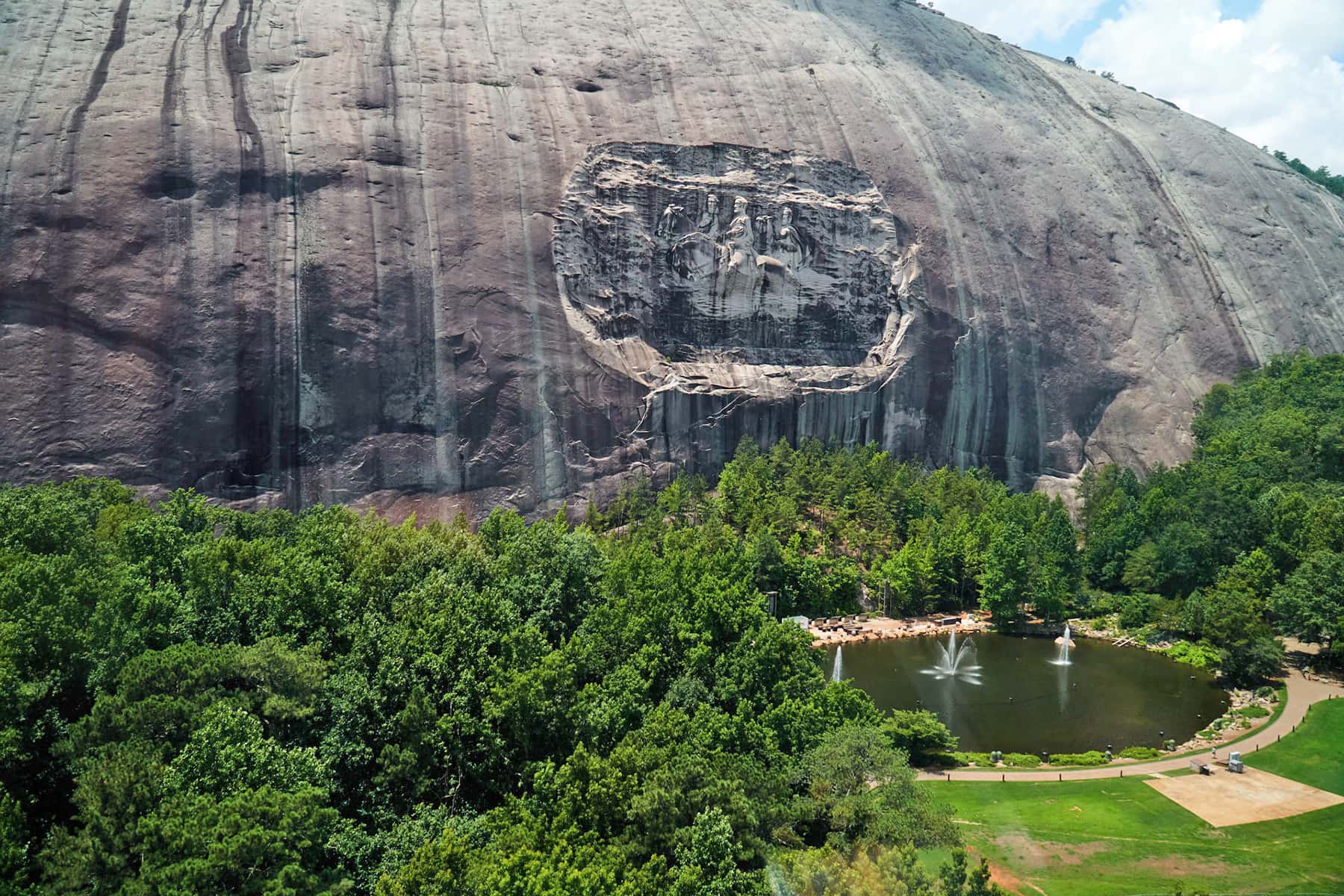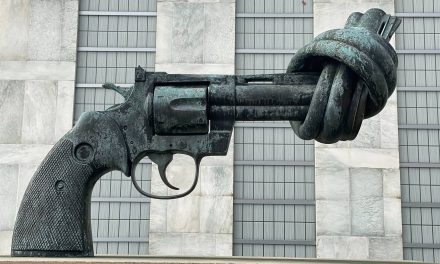
The largest celebration of the Confederacy should be obscured by vegetation and the park outside Atlanta repurposed away from white supremacy.
The current national attention to the interrelated issues of policy reform and representation, along with the murder of two Black men here in Georgia, got me thinking again about the state’s giant monument to white supremacy on the side of Stone Mountain.
It is too big to just tear down, like they are doing with statues in Richmond and elsewhere, but something is going to happen with it eventually. Anti-racist sentiment is growing, and the makeup of Georgia’s population is changing so fast that some kind of modification is inevitable. And while I believe decisions about what ultimately happens there should emerge from meaningful public engagement, I don’t believe we have to wait any longer to make change. Below are some ideas we can start to implement now.
First, some context and history.
Stone Mountain is a massive geological aberration. Often incorrectly identified as granite, the exposed rock is technically a “quartz monzonite dome monadnock” that extends underground for miles in every direction. The visible portion rises 1,686ft (514 meters) above sea level, or 825ft above the surrounding Georgia piedmont.
Located 14 miles east of downtown Atlanta, it sits within a 3,200-acre (1,294-hectare) forest-cum-theme-park that is owned by the state of Georgia and managed by the Stone Mountain Memorial Association. It is cited as “Georgia’s most visited attraction, drawing nearly 4 million guests each year”. Best known for its laser-light show that runs every night throughout the summer, the park also offers hiking, fishing, camping, paddle boats, an excursion train, a golf course, a Marriott conference center, educational exhibits and a handful of memorials to white supremacy.
The icon of Stone Mountain Park is one of those memorials. It’s also the largest bas-relief sculpture in the world. Occupying the steep northern slope of the mountain and measuring 76ft tall by 158ft wide, the carving depicts the president of the Confederate States of America, Jefferson Davis, along with the Confederate generals Robert E Lee and Stonewall Jackson. They are riding their favorite horses with their hats over their hearts. Like most southern civil war memorials, their real purpose is to instill in us a 20th-century romanticized narrative about the American south that helps maintain white supremacy through a segregated and unequal society.
The sculpture is an irreparable scar on an ancient mountain with a long history of habitation and use by indigenous people. More blatantly offensive, however, is the sculpture’s undeniable reverence for hate and violence and the honor it bestows on the generals, who, by definition, were American traitors. We need to change that, but before we jump to ideas about the fate of the sculpture itself, it is important to dismiss any claim of valor or heritage so that we can all agree that that fate – whatever it is – is long overdue.
The story of the sculpture’s “heritage” began one November night in 1915, 50 years after the end of the American civil war. Fifteen men burned a cross atop the mountain and marked the founding of the modern Ku Klux Klan. The next year, Samuel Venable, a Klansman and quarry operator who owned the property, deeded its north face to the United Daughters of the Confederacy (UDC), which planned the original carving. They commissioned the work to a Klan sympathizer – a sculptor named Gutzon Borglum, who after quitting the project in 1925, would go on to carve Mount Rushmore. Another sculptor continued the project for three years until the UDC ran out of money. At that point, only Robert E Lee’s head was complete, and the project languished for 30 years.
In 1958, just four years after Brown v Board of Education and two years after the Confederate battle emblem was added to Georgia’s flag (it was removed in 2001), the state purchased Stone Mountain for the creation of a Confederate memorial park. Five years later, in 1963 – the very same year that Martin Luther King proclaimed in his I Have A Dream speech, “Let freedom ring from the Stone Mountain of Georgia!” – the state restarted the effort to finish the Confederate sculpture. Historian Grace Hale explains that to white state leaders at that time, “the carving would demonstrate to the rest of the nation that ‘progress’ meant not Black rights but the maintenance of white supremacy”.
Work on the sculpture continued throughout the 1960s while nearby Atlanta emerged as the cradle of the American civil rights movement, as the federal government passed landmark legislation such as the Voting Rights Act of 1965, and even after King was assassinated in 1968. Remarkably, only two years later in 1970, Spiro Agnew, the vice-president of the United States, was a participant at the sculpture’s unveiling. And over time, the park continued to evolve, with additional homages to white supremacy, including the names of streets like Robert E Lee Boulevard and Stonewall Jackson Drive, and a prominent role for the still-flying Confederate battle flag.
Meanwhile, the suburbs of Atlanta grew up around the park. And in an interesting twist of fate, by the end of the century, Atlanta’s suburbanizing African American middle class found themselves living in these once-white neighborhoods. Even more surprisingly, perhaps, despite the park’s overtly racist iconography, park visitors today are decidedly diverse, and modest efforts have been made to contextualize the Confederate memorials. For example, the end of the laser-light show animates the Confederate generals, who break their swords and gallop into the books of American history.
The terrorist attacks by domestic white supremacists in Charleston (2015) and Charlottesville (2017) renewed attention to the legacy of Stone Mountain’s carving. And today, our ongoing struggle with the seemingly relentless humiliation, incarceration and murder of Black Americans by systemic white supremacy make clear that contextualizing the carving through laser animation is not enough.
Something else needs to be done.
The public lands of Georgia must reflect a more accurate history of our people, and they must inspire in us a more aspirational view toward our future. After all, by 2028, Georgia is projected to have a majority non-white population – an ironic fate for a state that once protested the dream of its most famous native son, Dr King, by carving a memorial to white supremacy in the side of an ancient mountain.
In 2017, Mitch Landrieu, the mayor of New Orleans, addressed the removal of several Confederate statues in his city. “There is a difference between remembrance of history and reverence of it,” he said. “These monuments purposefully celebrate a fictional, sanitized Confederacy; ignoring the death, ignoring the enslavement, and the terror that it actually stood for.”
Today, with that perspective as our starting place, we must begin to transform Stone Mountain Park into a more aspirational symbol for our future. That will take time, but to set the tone for that dialogue, here are four things we can do now:
1. Stop cleaning the sculpture
State law protects the sculpture from destruction but does not require it to be clean. It remains clear of vegetation only through effort and expense. Trees and plants grow easily from the mountain’s other cracks and crevices. We should allow growth to also overtake the sculpture’s many clefts and crinkles as they naturally collect organic material and allow moss and lichen to obscure its details. We should blast it with soil to encourage such growth and consider this new camouflage as a deliberate creative act, transforming the sculpture into a memorial to the end of the war – not to the traitors who led it.
2. Stop mowing the lawn
Allow the Memorial Lawn to grow into a forest. It is not protected by the law. A major problem with Stone Mountain is the formal, triumphant view of the sculpture, making the entire park a celebration of white supremacy. Elimination of this view will also mean the end of the laser-light show – consider a replacement event that similarly draws people together, but instead around new symbols of peace and justice.
3. Update the park’s identity
Eliminate any other remaining references to the Confederacy. These are not protected by the law. Conduct a quick re-evaluation of all the names, signage, narrative, flags and iconography throughout the park and remove all problematic references, including the names of streets and lakes, programming and online content. Acknowledging the somber weight of history here, this should also include removal of the theme-park activities below the sculpture.
4. Plan a new park
Begin a dialogue for more sweeping changes at the park that will inspire required changes to state law. Consider an international design competition that refocuses the 3,200-acre park around its namesake geological feature and transforms it into a new symbol of peace and reconciliation. Consider proposals for future permanent modifications to the sculpture itself, as well as existing proposals for a mountaintop carillon that honors King’s dream by literally letting freedom ring at the top of every hour. Include the transformation of Memorial Hall into a Memorial to the End of the Confederacy – an honest interpretation of life in the American south, the civil war, the Reconstruction and Jim Crow eras, and subsequent efforts to romanticize the “Lost Cause” through memorials like Stone Mountain’s 1970 carving.
These proposed changes will not be enough. They are only a start, and only small part of a larger effort to ensure that the design and use of public land and public spaces reflect our highest values, and that those values actually shape the laws that regulate our land. And while we don’t know if challenging the law that protects Stone Mountain will work immediately, we do know that eventually, change is going to come. We have this fleeting opportunity to try to make it happen now, and to tell our children we stood up to hate.
If we wait, our children will have to do the work for us.
Ryаn Grаvеl and Scоtt Mоrrіs
Originally published on The Guardian as What we can do now about Stone Mountain’s 150ft Confederate carving?
Help deliver the independent journalism that the world needs, make a contribution of support to The Guardian.














